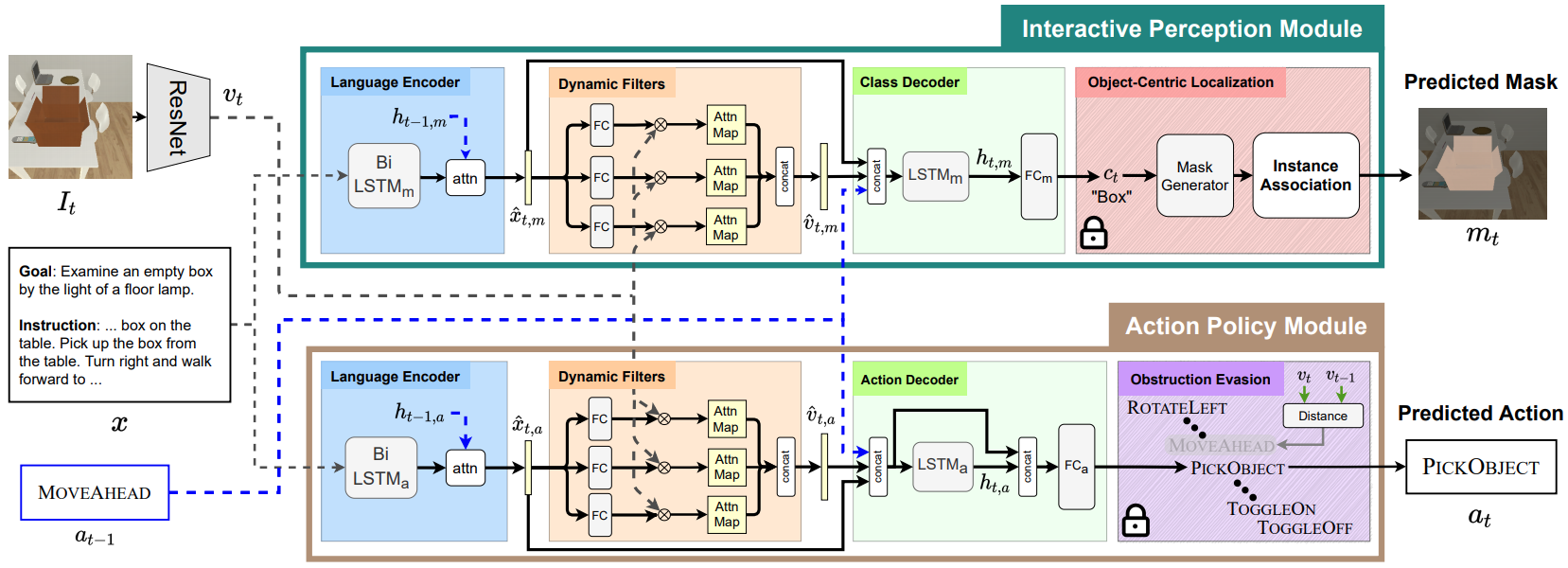Factorizing Perception and Policy for Interactive Instruction Following
Kunal Pratap Singh* ,
Suvaansh Bhambri* ,
Byeonghwi Kim* ,
Roozbeh Mottaghi ,
Jonghyun Choi
ICCV 2021
MOCA (Modular Object-Centric Approach) is a modular architecture that decouples a task into visual perception and action policy.
The action policy module (APM) is responsible for sequential action prediction, whereas the interactive perception module (IPM) generates pixel-wise interaction mask for the objects of interest for manipulation.
MOCA addresses long-horizon instruction following tasks based on egocentric RGB observations and natural language instructions on the ALFRED benchmark.
(Prev: MOCA: A Modular Object-Centric Approach for Interactive Instruction Following)
$ git clone https://github.com/gistvision/moca.git moca
$ export ALFRED_ROOT=$(pwd)/moca
$ virtualenv -p $(which python3) --system-site-packages moca_env
$ source moca_env/bin/activate
$ cd $ALFRED_ROOT
$ pip install --upgrade pip
$ pip install -r requirements.txt
Download the ResNet-18 features and annotation files from the Hugging Face repo.
git clone https://huggingface.co/datasets/byeonghwikim/abp_dataset data/json_feat_2.1.0
To train MOCA, run train_seq2seq.py with hyper-parameters below.
python models/train/train_seq2seq.py --data <path_to_dataset> --model seq2seq_im_mask --dout <path_to_save_weight> --splits data/splits/oct21.json --gpu --batch <batch_size> --pm_aux_loss_wt <pm_aux_loss_wt_coeff> --subgoal_aux_loss_wt <subgoal_aux_loss_wt_coeff>
Note: As mentioned in the repository of ALFRED, run with We provide the already preprocessed annotation files and the vocab file. You may not need to run the code with --preprocess only once for preprocessed json files.--preprocess.
Note: All hyperparameters used for the experiments in the paper are set as default.
For example, if you want train MOCA and save the weights for all epochs in "exp/moca" with all hyperparameters used in the experiments in the paper, you may use the command below.
python models/train/train_seq2seq.py --dout exp/moca --gpu --save_every_epoch
Note: The option, --save_every_epoch, saves weights for all epochs and therefore could take a lot of space.
To evaluate MOCA, run eval_seq2seq.py with hyper-parameters below.
To evaluate a model in the seen or unseen environment, pass valid_seen or valid_unseen to --eval_split.
python models/eval/eval_seq2seq.py --data <path_to_dataset> --model models.model.seq2seq_im_mask --model_path <path_to_weight> --eval_split <eval_split> --gpu --num_threads <thread_num>
Note: All hyperparameters used for the experiments in the paper are set as default.
If you want to evaluate our pretrained model saved in exp/pretrained/pretrained.pth in the seen validation, you may use the command below.
python models/eval/eval_seq2seq.py --model_path "exp/pretrained/pretrained.pth" --eval_split valid_seen --gpu --num_threads 4
To evaluate MOCA for subgoals, run eval_seq2seq.py with with the option --subgoals <subgoals>.
The option takes all for all subgoals and GotoLocation, PickupObject, PutObject, CoolObject, HeatObject, CleanObject, SliceObject, and ToggleObject for each subgoal.
The option can take multiple subgoals.
For more details, refer to ALFRED.
python models/eval/eval_seq2seq.py --data <path_to_dataset> --model models.model.seq2seq_im_mask --model_path <path_to_weight> --eval_split <eval_split> --gpu --num_threads <thread_num> --subgoals <subgoals>
Note: All hyperparameters used for the experiments in the paper are set as default.
If you want to evaluate our pretrained model saved in exp/pretrained/pretrained.pth in the seen validation for all subgoals, you may use the command below.
python models/eval/eval_seq2seq.py --model_path "exp/pretrained/pretrained.pth" --eval_split valid_seen --gpu --num_threads 4 --subgoals all
Trained and Tested on:
- GPU - GTX 2080 Ti (11GB)
- CPU - Intel(R) Core(TM) i9-9900K CPU @ 3.60GHz
- RAM - 32GB
- OS - Ubuntu 18.04
MIT License
@article{singh2021factorizing,
title={Factorizing Perception and Policy for Interactive Instruction Following},
author={Singh, Kunal Pratap and Bhambri, Suvaansh and Kim, Byeonghwi and Mottaghi, Roozbeh and Choi, Jonghyun},
journal={ICCV},
year={2021}
}
